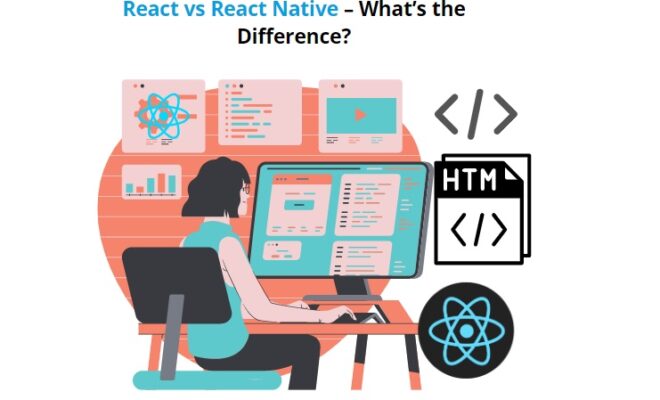React vs React Native – What’s the Difference?

In 2011, as Facebook ads were growing and introducing newer exciting features, the engineers discovered that the constant updates were slowing the speed of channel. Changes and updates that cascaded through the content required the developers to redesign the entire application. The team’s size grew as the number of issues increased at the same rate.
Then the engineer at Facebook, Jordan Walke, utilized XHP (an HTML component library compatible with PHP) to develop FaxJS, the first prototype for React JS.
It led to the creation of React Native as a framework. The development community witnessed the advent of two robust technologies. React Js against React Native is an interesting comparison that forces developers to consider their utility and their application to creating web-based apps, mobile apps, web applications that are mobile-responsive, as well as much more
React Native or React JS; A well-guided comparison in these respective fields
What is React JS?
React JS is a JavaScript library that can be used to support both the server and front end. It can also be used to design the user interfaces of mobile applications and web pages.
What aspects of React JS is its USP from a business perspective? (Advantages of React JS)
Faster with DOM
From a business standpoint from a business perspective, one important USP of React JS comes from the ability to deliver blazing speed speeds for websites and applications developed by making use of React JS DOM as well as the Document Object Model.
Component-Based Architecture Saves Time
React JS brought the notion of a component-based architecture that ensures the reuse of the components and, as a result, can save a significant amount of time.
This component-based design takes the individual components of a user interface and transforms the components into an independent self-sustaining micro-system.
ReactJS Gives Power-boost to SEO
Because Reactjs can do rendering server-side, it adds an additional boost to the SEO of an app or website and draws greater organic visitors. It provides a big warning to the overall SEO strategy for the site.
Huge Ecosystem of Developer Tools
React JS is fortunate to have an enormous group of developers who have developed an extensive community of tools, component libraries, IDEs, extensions to web browsers, code editors, and many more.
The accessibility of a wide variety of third-party extensions and tools opens up the potential for new creativity while saving time and money simultaneously. The power of community-driven innovation makes React JS one of the most sought-after choices for developing innovative, ground-breaking applications and websites.
What do you mean by React Native?
React Native is an open-source mobile framework that uses React JS to build websites and applications. React Native can compile native app components that allow developers to create mobile apps run on various platforms, including Windows, Android, and iOS using JavaScript.
Pros of using React Native; Significant USP from a business standpoint?
Advantage Platform-specific Code
One of the most important USPs of creating websites and applications with React Native is the ability to write code that is specific to a particular platform.
If you choose to use React Native to create an application, the framework automatically detects the platform that it is running on. In this way, it makes the correct code for the appropriate forum.
Front-end developers can use React Native to create an application
Since the majority of the code used within React Native is Javascript, it is easier for front-end developers to develop an app in a short time.
It’s pretty easy for front-end developers to learn the technology. All they have to learn is Javascript (specifically Reactjs) and platform APIs, indigenous UI elements, and designs that are specific to a platform.
The hot reloading feature minimizes the development time
ReactJS can support its Hot Reloading feature, which lets developers refresh mobile apps in a timely manner.
This makes development quick and can cut down on time.
Libraries for UI that are ready-to-use to give you a smoother UI experience
Component UI libraries are part of the React Native ecosystem. Developers can utilize it to create a smooth UI experience.
This sharing of UI libraries like Shoutem, Expo, native base, and more reduce the time needed to create these libraries from scratch. It means more attention to new ideas and innovations can be put into place instead of creating new libraries.
What are the significant distinctions in React JS in comparison to React Native?
React JS is described as a derivative of base React DOM to be used on Web Platform However, React Native is an independent base derivative meaning its syntax and workflow are the same; however, the components are changed.
React JS is a JavaScript library that allows programmers to build an engaging and efficient UI layer. React Native offers a complete framework to build cross-platform web-based applications, iOS or Android.
In React JS, virtual DOM renders browser-specific software in Reactjs, and when using React Native, native APIs serve to render elements on mobile devices. CSS is used to style the React JS, and developers can use a stylesheet to include different styles to create custom-made applications.
If you have React JS projects, hire a certified React JS development company for better guidance and outcomes.










